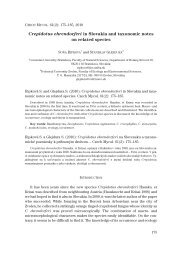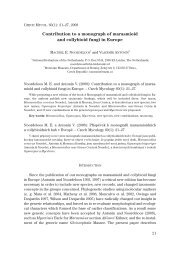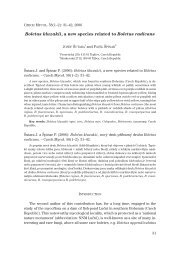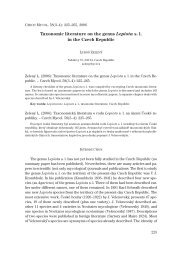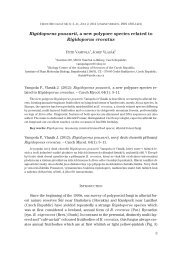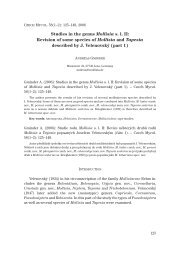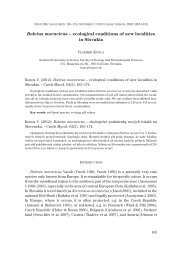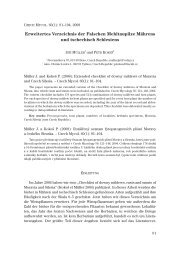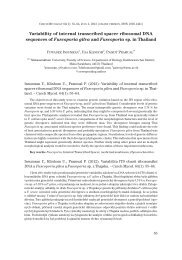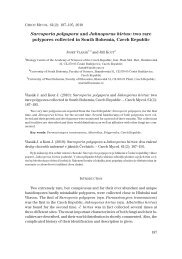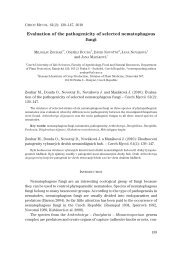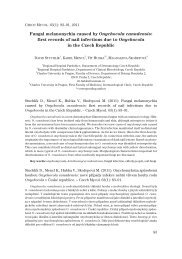Erysiphe azaleae (Erysiphales) - CZECH MYCOLOGY
Erysiphe azaleae (Erysiphales) - CZECH MYCOLOGY
Erysiphe azaleae (Erysiphales) - CZECH MYCOLOGY
Create successful ePaper yourself
Turn your PDF publications into a flip-book with our unique Google optimized e-Paper software.
<strong>CZECH</strong> MYCOL. 58(3–4): 189–199, 2006<br />
<strong>Erysiphe</strong> <strong>azaleae</strong> (<strong>Erysiphales</strong>) – a new species of powdery<br />
mildew for Slovakia and further records<br />
from the Czech Republic<br />
KAMILA BACIGÁLOVÁ 1 and JAROSLAVA MARKOVÁ 2<br />
1<br />
Institute of Botany of the Slovak Academy of Sciences, Department of Non-vascular Plants,<br />
Dúbravská cesta 14, SK – 845 23 Bratislava, Slovakia<br />
kamila.bacigalova@savba.sk<br />
2<br />
Department of Botany, Charles University, Benátská 2, CZ –128 01 Praha 2, Czech Republic<br />
markovaj@natur.cuni.cz<br />
Bacigálová K. and Marková J. (2006): <strong>Erysiphe</strong> <strong>azaleae</strong> (<strong>Erysiphales</strong>) – a new<br />
species of powdery mildew for Slovakia and further records from the Czech Republic.<br />
– Czech Mycol. 58(3–4): 189–199.<br />
<strong>Erysiphe</strong> <strong>azaleae</strong>, a powdery mildew growing on deciduous Rhododendron species is reported from<br />
the Slovak and Czech Republics. A detailed description is given and its distribution in Europe is discussed.<br />
Key words: Erysiphaceae, powdery mildew, Rhododendron, Azalea, Central Europe<br />
Bacigálová K. a Marková J. (2006): <strong>Erysiphe</strong> <strong>azaleae</strong> (<strong>Erysiphales</strong>) – nový druh padlí<br />
pro Slovensko a další nálezy v České republice. – Czech Mycol. 58(3–4): 189–199.<br />
<strong>Erysiphe</strong> <strong>azaleae</strong>, padlí na opadavých druzích rodu Rhododendron, bylo nalezeno na území Slovenska<br />
a České republiky. Je uveden popis druhu a údaje o jeho rozšíření v Evropě.<br />
INTRODUCTION<br />
Recently an increasing number of reports on the appearance of new powdery mildew<br />
species (<strong>Erysiphales</strong>) in various parts of Europe have been published, and the<br />
distribution areas have been extended: e. g. <strong>Erysiphe</strong> vanbruntiana (W.R.Gerard)<br />
U. Braun et S. Takam. on Sambucus racemosa and Sambucus nigra, <strong>Erysiphe</strong><br />
palczewskii (Jacz.) U. Braun et S. Takam. on Caragana arborescens (Romaszewska-<br />
Sałata et al. 1982, 1986), <strong>Erysiphe</strong> syringae Schwein. on Syringa vulgaris (Braun<br />
1995), <strong>Erysiphe</strong> flexuosa (Peck) U. Braun et S. Takam. on Aesculus hippocastanum<br />
(Ale-Agha et al. 2000, Ing and Spooner 2002, Piątek 2002, Zimmermannová-<br />
Pastirčáková and Pastirčák 2002, Zimmermannová-Pastirčáková et al. 2002,<br />
Wołczańska and Mułenko 2002), <strong>Erysiphe</strong> syringae-japonicae (U. Braun) U. Braun<br />
et S. Takam. on various Syringa species in Poland (Piątek 2003), <strong>Erysiphe</strong> elevata<br />
(Burrill) U. Braun et S. Takam. on Catalpa species (Ale-Agha et al. 2004) and<br />
Phyllactinia corni H. D. Shin et Y. J. La on Cornus mas (Bacigálová et al. 2005).<br />
189
<strong>CZECH</strong> MYCOL. 58(3–4): 189–199, 2006<br />
An outbreak of powdery mildew was noticed also on various Rhododendron<br />
species in Europe. At first the fungus was found only in the anamorph state and<br />
could not be exactly identified (Watling 1985, Braun 1987, Basden and Helfer 1995,<br />
Labanowski and Orlikowski 1997, Ing 2000, Inman et al. 2000). The powdery mildew<br />
species parasitising on Rhododendron were described as Oidium ericinum<br />
Erikss., <strong>Erysiphe</strong> vaccinii Schwein. (Braun 1987), Microsphaera <strong>azaleae</strong> U. Braun<br />
(now <strong>Erysiphe</strong> <strong>azaleae</strong> (U. Braun) U. Braun et S. Takam.) (Braun and Takamatsu<br />
2000), Microsphaera penicillata (Wallr.: Fr.) Lév. (Labanowski and Orlikowski 1997)<br />
and Microsphaera digitata A. J. Inman et U. Braun (Inman et al. 2000).<br />
<strong>Erysiphe</strong> <strong>azaleae</strong> (U. Braun) U. Braun et S. Takam. is a native North American<br />
powdery mildew originally described as Microsphaera <strong>azaleae</strong> by Braun (1982)<br />
based on a North American collection of infected leaves of Rhododendron<br />
nudiflorum (L.) Torr.<br />
The first record of the teleomorph state of <strong>Erysiphe</strong> <strong>azaleae</strong> in Europe was<br />
published from Germany (Braun 1997). Later, the fungus ascomata (cleistothecia)<br />
were also found on various Rhododendron species in Switzerland (Inman et al.<br />
2000, Bolay 2001), England (Ing 2000), Italy (Garibaldi et al. 2002), Poland (Piątek<br />
2003, Shin and Mułenko 2004) and in the Czech Republic (Lebeda et al. 2006).<br />
First finds of <strong>Erysiphe</strong> <strong>azaleae</strong> from the Slovak Republic are reported here.<br />
MATERIAL AND METHODS<br />
Material examined<br />
On Rhododendron luteum Sweet, S l o v a k i a : Podunajská nížina Basin,<br />
Tesárske Mlyňany, Arboretum, 7. X. 2005, leg. K. Bacigálová, SAV; Podunajská nížina<br />
Basin, Bratislava, Botanical Garden, 11. X. 2005, 28. X. 2005, leg. K. Bacigálová, SAV;<br />
Podunajská nížina Basin, Bratislava-Prievoz, Parková street, 30. X. 2005, leg.<br />
A. Petrík, SAV; C z e c h R e p u b l i c : Praha, Botanical Garden of Charles University,<br />
20. IX. 2005, leg. J. Marková, PRC; western Bohemia: Klenčí pod Čerchovem, Díly,<br />
18. IX. 2005, leg. D. Kozáková, PRC.<br />
On Rhododendron canadense Torr., S l o v a k i a : Podunajská nížina Basin,<br />
Tesárske Mlyňany, Arboretum, 7. X. 2005, leg. K. Bacigálová, SAV.<br />
On Rhododendron seedling, S l o v a k i a : Podunajská nížina Basin, Tesárske<br />
Mlyňany, Arboretum, 7. X. 2005, leg. K. Bacigálová, SAV.<br />
On Rhododendron hybrids, cv. Berryrose, cv. Christopher Wren, cv. Exbury White,<br />
cv. Golden Sunset, cv. Homebush, cv. Hortulanus H. Witte, cv. Persil, cv. Pontica, cv.<br />
Samba, cv. Sylphides, S l o v a k i a : Podunajská nížina Basin, Tesárske Mlyňany, Arboretum,<br />
7. X. 2005, leg. K. Bacigálová, SAV; cv. Mollis von Gneist, Podunajská nížina Basin,<br />
Bratislava, Botanical Garden, 11. X. 2005, leg. K. Bacigálová, SAV; cv. Feuerwerk,<br />
cv. Strawberry Ice; C z e c h R e p u b l i c : central Bohemia, Mirošovice near Praha,<br />
190
BACIGÁLOVÁ K. AND MARKOVÁ J.: ERYSIPHE AZALEAE – A NEW SPECIES FOR SLOVAKIA<br />
A<br />
C<br />
D<br />
B<br />
E<br />
F<br />
Fig. 1. <strong>Erysiphe</strong> <strong>azaleae</strong> – symptoms on Rhododendron cv. Feuerwerk:<br />
A, B, C – upper side of leaves; D – lower side with ascomata; E, F – anamorph on flowers and fruits.<br />
191
<strong>CZECH</strong> MYCOL. 58(3–4): 189–199, 2006<br />
A<br />
B<br />
D<br />
C<br />
E<br />
Fig. 2. <strong>Erysiphe</strong> <strong>azaleae</strong> – teleomorphic characteristics: A, B, C – ascoma showing variability in number<br />
and branching of appendages; appendages are thick-walled at the base and thinner upwards,<br />
branching is regular, close and compact with recurved apex; D–several sessile asci with ascospores; E<br />
– ascus with short stalk. Bar = 50 μm.<br />
192
BACIGÁLOVÁ K. AND MARKOVÁ J.: ERYSIPHE AZALEAE – A NEW SPECIES FOR SLOVAKIA<br />
28. IX. 2005 and 8. VII. 2006, leg. J. Marková, PRC; cv. div., Praha, Botanical Garden<br />
of Charles University, 20. IX. 2005, leg. J. Marková, PRC.<br />
For identification of the fungus both visual symptoms of infected plants and<br />
anatomical-morphological characteristics were used. The teleomorph and<br />
anamorph state were observed in a drop of 50 % lactic acid coloured with<br />
methylen blue. For observations a Zeiss light microscope with a microphotographic<br />
attachment was employed. For cleistothecia, asci and ascospores 100<br />
cleistotthecia, asci and ascospores were measured, n = 100. In Tab. 1., the following<br />
abbreviations are used: x – arithmetical mean of all cleistothecia, N – the most<br />
frequent number of appendages, asci and ascospores.<br />
The collected material was deposited in the Mycological Herbarium of the Institute<br />
of Botany of the Slovak Academy of Sciences (SAV) and the Herbarium of<br />
the Faculty of Natural Sciences, Charles University, Prague (PRC).<br />
RESULTS AND DISCUSSION<br />
<strong>Erysiphe</strong> <strong>azaleae</strong> (U. Braun) U. Braun et S. Takamatsu<br />
Syn. Microsphaera <strong>azaleae</strong> U. Braun<br />
M y c e l i u m on leaves amphigenous, mostly epiphyllous, whitish to pale grey,<br />
rather persistent, forming small patches on the upper leaf surface ( Figs. 1 A, B, C)<br />
and moreover on fruits (Figs. 1 E, F).<br />
C l e i s t o t h e c i a usually hypophyllous (Fig. 1 D), gregarious, brownish,<br />
92–183 (x 128) μm diam., cells irregularly polygonal, with numerous appendages<br />
(Tab. 1), equatorial, hyaline, (61–)92–199 μm long, aseptate or with one septum at<br />
the base, thick-walled towards the base, thinner upwards, apex 4–6 times regularly<br />
branched, close, with re-curved apex (Figs. 2 A, B, C).<br />
A s c i 4–9, sessile or short-stalked, (52–)55–73 × 30–49 μm, a s c o s p o r e s 4–8<br />
per ascus; ellipsoid or slightly ovoid, hyaline, 18–25 × 12 μm (Tab. 1, Figs. 2 D, E).<br />
C o n i d i a l s t a t e : hyphae hyaline, substraight to wavy, geniculate, 31–70 ×<br />
4–7 μm, mostly branching at right angles, usually with a septum near the branching<br />
point (Fig. 3 A). A p p r e s s o r i a well developed, multilobed to moderately<br />
lobed, in pairs or single. C o n i d i ophores (primary and secondary) single<br />
on a hyphal cell, arising from the upper or lateral part of mother cells, mostly<br />
in central position, 31–80 × 5–7 μm in epiphyllous ones, 45–125 × 4–7 μm in<br />
hypophyllous ones, usually becoming broader upwards, neither constricted nor<br />
swollen at the branching point of the mycelium, producing single conidia followed<br />
by 1(–2) immature cells and a rather long foot-cell (25–50 μm), thus mostly composed<br />
of 3 cells when mature, occasionally appearing as forming short chains by<br />
somewhat broadening or swelling of the second cell, twisted or kinked to flexu-<br />
193
<strong>CZECH</strong> MYCOL. 58(3–4): 189–199, 2006<br />
ous at the base of foot-cells, with a basal septum at the branching point of the mycelium<br />
(Figs. 3 A, D, E).<br />
P r i m a r y c o n i d i a differentiated from secondary conidia by having<br />
a rounded apex and subtruncate base, mostly smaller than the secondary ones,<br />
20–25–34 × 12–18 μm, broadest part non-median, obovoid with broad subtruncate<br />
base, producing germ tubes at the basal or terminal end.<br />
Secondary conidia oblongtocylindrical,mostlysymmetricatbothends,20–<br />
46 × 12–18 μm without fibrosin bodies, producing terminal germ tubes (Figs. 3 B, C).<br />
N o t e . The cleistothecia of E. <strong>azaleae</strong> in our collection show some variability<br />
in both number of appendages and branching of the apex of the appendages (Figs.<br />
2 A, B, C) in correspondence with the characteristics by Braun (1982).The<br />
anamorph state of E. <strong>azaleae</strong> is positively consistent with the anamorphic characteristics<br />
by Shin and Mułenko (2004). The most distinctive features were the kinking<br />
of the basal part of the conidiophore foot-cells (Fig. 3), and a differentiation of<br />
conidiophores composed of 2–4 cells. The primary conidiophore bearing a primary<br />
conidium at the apex (Figs. 3 B, D) and a subtruncate apex of the apical cell<br />
characterises the secondary conidiophore with 2–4 cells (Fig. 3 E) having symmetric<br />
ends (Figs. 3 B, C).<br />
The mycoparasite Ampelomyces quisqualis Ces. (Fig. 4), an antagonist of<br />
powdery mildews, has appeared on the leaves of Rhododendron cv. Feuerwerk<br />
(collected 8. July 2006 in Mirošovice) and R. luteum (coll. 11 October 2005 in Botanical<br />
Garden Bratislava), covered by a powdery mildew anamorph and has prevented<br />
formation of cleistothecia all the vegetative season round. This is the first<br />
record of this mycoparasite on powdery mildew <strong>Erysiphe</strong> <strong>azaleae</strong> from Rhododendron<br />
in our ecological conditions and we hope it will initiate further studies.<br />
Our finds (Czech and Slovak Republics) represent the sixth and seventh European<br />
countries in which <strong>Erysiphe</strong> <strong>azaleae</strong> has been detected. The Slovak finds<br />
come from Rhododendron luteum and various cultivars grown in Arboretum<br />
Mlyňany, Slovak Academy of Science (southwest Slovakia) and in the Town Garden<br />
Centre in Bratislava-Prievoz. The Czech material was collected in central and western<br />
Bohemia. The Rhododendron species were severely infected by the powdery<br />
mildew. According to personal communication with the gardener, the occurrence<br />
of powdery mildew on deciduous Rhododendron species in the Botanical Garden of<br />
Charles University in Prague was remarkable even in the autumn of 2004. <strong>Erysiphe</strong><br />
<strong>azaleae</strong> occurred also in Olomouc, Ostrava and Zlin (Lebeda et al. 2006) and in the<br />
Arboretum of Mendel University of Agriculture and Forestry in Brno in 2004–2006<br />
(personal communication).The all samples of our collection contained a great number<br />
of mature ascomata on both sides of the leaves together with a sparse conidial<br />
state. In the territory of Bratislava, Botanical Garden, <strong>Erysiphe</strong> <strong>azaleae</strong> has been<br />
found for the first time only in Oidium state. The records from the Czech and Slovak<br />
territories indicate that the fungus is spreading eastwards in Europe.<br />
194
BACIGÁLOVÁ K. AND MARKOVÁ J.: ERYSIPHE AZALEAE – A NEW SPECIES FOR SLOVAKIA<br />
B<br />
C<br />
A<br />
D<br />
E<br />
Fig. 3. <strong>Erysiphe</strong> <strong>azaleae</strong> – anamorphic characteristics: A–the kinked mother cell at the base of foot-cell conidiophores;<br />
B, C – primary conidia (p) and secondary conidia (s); D – primary conidiophore; E–secondary conidiophore.<br />
Bar = 10 μm.<br />
195
<strong>CZECH</strong> MYCOL. 58(3–4): 189–199, 2006<br />
A<br />
B<br />
C<br />
Fig. 4. Mycoparasite Ampelomyces quisqualis: A, B – pycnidia formed within conidiophores of powdery<br />
mildew; C – the same stained with cotton blue.<br />
196
BACIGÁLOVÁ K. AND MARKOVÁ J.: ERYSIPHE AZALEAE – A NEW SPECIES FOR SLOVAKIA<br />
Tab. 1. Comparative characters of the teleomorph state of <strong>Erysiphe</strong> <strong>azaleae</strong> on Rhododendron species<br />
in Slovakia and Czech Republic.<br />
Rhododendron species<br />
(locality)<br />
Cleistothecia<br />
(µm)<br />
Appendage<br />
(N) / (µm)<br />
Ascus<br />
(N) / (µm)<br />
Ascospore<br />
(N) / (µm)<br />
Rhododendron canadense<br />
(Arboretum Mlyňany)<br />
120<br />
(x 120)<br />
(20–23)<br />
61–122<br />
immature<br />
immature<br />
Rhododendron luteum<br />
(Arboretum Mlyňany)<br />
92–122<br />
(x 104)<br />
(15–16)<br />
145–199<br />
(6)<br />
61–67 × 30–36<br />
(6)<br />
21–25 × 12<br />
R. luteum<br />
(Bratislava-Prievoz)<br />
110–153<br />
(x 124)<br />
(14–22)<br />
131–189<br />
(8)<br />
67–73 × 36–43<br />
(6–8)<br />
18–21 × 12<br />
R. luteum<br />
(Praha – Botanical Garden)<br />
116–141<br />
(x 131)<br />
(18–22)<br />
141–168<br />
(6)<br />
55–61 × 36–43<br />
(6–8)<br />
21 × 12<br />
R. luteum<br />
(Díly near Klenčí)<br />
110–153<br />
(x 129)<br />
(18–22)<br />
98–153<br />
(4)<br />
55 × 37<br />
(6)<br />
21 × 12<br />
Rhododendron cv. Berryrose<br />
(Arboretum Mlyňany)<br />
130–147<br />
(x 138)<br />
(17–18)<br />
92–122<br />
(7)<br />
67–73 × 36–43<br />
(4–5)<br />
21 × 12<br />
R. cv. Christopher Wren<br />
(Arboretum Mlyňany)<br />
128–174<br />
(x 140)<br />
(16–18)<br />
122–137<br />
(4)<br />
73 × 48<br />
(6)<br />
18 × 12<br />
R. cv. Exbury White<br />
(Arboretum Mlyňany)<br />
104–153<br />
(x 122)<br />
(12)<br />
104–130<br />
(6–9)<br />
55–67 × 30–43<br />
(6–8)<br />
21 × 12<br />
R. cv. Golden Sunset<br />
(Arboretum Mlyňany)<br />
110–141<br />
(x 129)<br />
(16–18)<br />
120–137<br />
(6–8)<br />
61–64 × 37–43<br />
(6)<br />
21 × 12<br />
R. cv. Homebush<br />
(Arboretum Mlyňany)<br />
116–153<br />
(x 137)<br />
(22–26)<br />
137–153<br />
(6)<br />
55–67 × 30–43<br />
(8)<br />
24 × 12<br />
R. cv. Hortulanus H. Witte<br />
(Arboretum Mlyňany)<br />
116–160<br />
(x 141)<br />
(16–21)<br />
92–122<br />
(6–8)<br />
55–73 × 31–49<br />
(6–8)<br />
18 × 12<br />
R. cv. Persil<br />
(Arboretum Mlyňany)<br />
122–183<br />
(x 142)<br />
(20–26)<br />
92–183<br />
(7)<br />
61–73 × 30–42<br />
(6)<br />
25 × 12<br />
R. cv. Pontica<br />
(Arboretum Mlyňany)<br />
110–134<br />
(x 124)<br />
(24–33)<br />
92–122<br />
(6)<br />
61–67 × 36–43<br />
(6)<br />
21 × 12<br />
R. cv. Samba<br />
(Arboretum Mlyňany)<br />
122–153<br />
(x 139)<br />
(16–25)<br />
107–122<br />
(6–7)<br />
55–67 × 36–42<br />
(6)<br />
18 × 12<br />
R. cv. Sylphides<br />
(Arboretum Mlyňany)<br />
104–153<br />
(x 122)<br />
(15–19)<br />
92–107<br />
(6–8)<br />
52–55 × 30–40<br />
(6)<br />
21 × 12<br />
R. cv. Strawberry Ice<br />
(Mirošovice)<br />
104–153<br />
(x 122)<br />
(22–27)<br />
92–122<br />
(6–8)<br />
55–70 × 37–43<br />
(6)<br />
18–21 × 12<br />
R. seedling<br />
(Arboretum Mlyňany)<br />
128–147<br />
(x 137)<br />
(16–22)<br />
122–153<br />
(6–8)<br />
61–67 × 37–43<br />
(6)<br />
25 × 12<br />
R. cv. div.<br />
(Praha – Botanical Garden)<br />
110–116<br />
(x 113)<br />
(20–25)<br />
92–122<br />
(4–8)<br />
55–67 × 37–43<br />
(6)<br />
21 × 12<br />
197
<strong>CZECH</strong> MYCOL. 58(3–4): 189–199, 2006<br />
ACKNOWLEDGEMENTS<br />
This study was supported by Slovak Grant Agency VEGA, project no. 2/4032/04.<br />
The authors would like to thank RNDr. Anton Petrík (Botanical Garden<br />
Bratislava, Slovakia) and Ing. Peter Hoťka (Arboretum Mlyňany, Slovakia) for collecting<br />
and providing access to their Rhododendron specimens infected by powdery<br />
mildew, and RNDr. E. Záletová for critical reading of the manuscript.<br />
REFERENCES<br />
ALE-AGHA N., BRAUN U., FEIGE B. and JAGE H. (2000): A new powdery mildew disease on Aesculus spp.<br />
introduced in Europe. – Cryptog. Mycol. 21(2): 89–92.<br />
ALE-AGHA N., BOLAY A., BRAUN U., FEIGE B., JAGE H., KUMMER V., LEBEDA A., PIĄTEK M., SHIN H. D. and<br />
ZIMMERMANOVÁ-PASTIRČÁKOVÁ (2004): <strong>Erysiphe</strong> catalpae and <strong>Erysiphe</strong> elevata in Europe. –<br />
Mycol. Progr. 3(4): 291–296.<br />
BACIGÁLOVÁ K., TÓTH D. and BRINZA J. (2005): Phyllactinia corni – a new for Slowakia powdery mildew<br />
causing disease of Cornus mas (Cornaceae). – Plant Protection Science 41/2: 90–93.<br />
BASDEN N. and HELFER S. (1995): World survey of Rhododendron powdery mildews. – J. Amer. Rhododendron<br />
Soc. 49: 147–156.<br />
BOLAY A. (2001): Loidium des rhododendrons cultivés en Suisse. – Revue Suisse Vitic. Arboric. Hortic.<br />
33(3): 131–134.<br />
BRAUN U. (1982): Descriptions of new species and combinations in Microsphaera and <strong>Erysiphe</strong>. –<br />
Mycotaxon 14(1): 369–374.<br />
BRAUN U. (1987): A monograph of the <strong>Erysiphales</strong> (powdery mildews). – Beih. Nova Hedwigia 89:<br />
1–700.<br />
BRAUN U. (1995): The powdery mildews (<strong>Erysiphales</strong>) of Europe. – 337 p. Jena etc.<br />
BRAUN U. (1997): Microsphaera <strong>azaleae</strong> U. Braun (<strong>Erysiphales</strong>). –<br />
www.botanik.biologie.uni-muenchen.de/botsamml/arnoldia/mifufc08.html.<br />
BRAUN U. and TAKAMATSU S. (2000): Phylogeny of <strong>Erysiphe</strong>, Microsphaera, Uncinula (Erysiphae) and<br />
Cystotheca, Podosphaera, Sphaerotheca (Cystotheceae) inferred from rDNA ITS sequences – some<br />
taxonomic consequences. – Schlechtendalia 4: 1–33.<br />
GARIBALDI A., GILARDI G., BERTETTI D. and GULLINO M. L. (2002): First report of powdery mildew on<br />
Azalea cv. Mollis (Rhododendrum japonicum x R. molle) in Italy. – Plant Disease 86: 329.<br />
ING B. (2000): Microsphaera <strong>azaleae</strong>, the perfect state of the Rhododendron mildew in England. – Mycologist<br />
14(4): 165.<br />
ING B. and SPOONER B. (2002): The horse chestnut powdery mildew Uncinula flexuosa in Europe (New<br />
British Record 210). – Mycologist 16: 112–113.<br />
INMAN A. J., COOK R. T. A. and BEALES P. A. (2000): A contribution to the identity of Rhododendron powdery<br />
mildew in Europe. – J. Phytopathol. 148: 17–27.<br />
ŁABANOWSKI G. and ORLIKOWSKI L., eds. (1997): Ochrana roślin iglastych i wtzosowatych. – 125 p.<br />
Kraków.<br />
LEBEDA A., SEDLÁŘOVÁ M., JANKOVSKÝ L. and SHIN H. D. (2006): First report of rhododendron powdery<br />
mildew on Rhododendron spp. in Czech Republic. – New Disease Reports 14<br />
[on-line http://www.bspp.org.uk/ndr/jan.2007/2006–67, accepted for publication 8. Sept 2006].<br />
PIĄTEK M. (2002): <strong>Erysiphe</strong> flexuosa, a new for Poland powdery mildew causing disease of Aesculus<br />
hippocastanum. – Phytopathol. Pol. 24: 67–71.<br />
198
BACIGÁLOVÁ K. AND MARKOVÁ J.: ERYSIPHE AZALEAE – A NEW SPECIES FOR SLOVAKIA<br />
PIĄTEK M. (2003): <strong>Erysiphe</strong> <strong>azaleae</strong> and <strong>Erysiphe</strong> syringae-japonicae introduced in Poland. –<br />
Mycotaxon 87: 121–126.<br />
ROMASZEWSKA-SAŁATA J., SAŁATA B. and MUŁENKO W. (1982): Microsphaera vanbruntiana Gerard –<br />
a new fungus species in Polish flora. – Ann. Univ. Maria Curie-Skłodowska, Sect. C 37: 195–199 (in<br />
Polish with English summary).<br />
ROMASZEWSKA-SAŁATA J., SAŁATA B. and MUŁENKO W. (1986): On some interesting representatives of<br />
Peronosporales and <strong>Erysiphales</strong> collected recently in Poland. – Folia Soc. Sci. Lublinensis, Biol.<br />
28: 11–18 (in Polish with English summary).<br />
SHIN H. D. and MUŁENKO W. (2004): The record of <strong>Erysiphe</strong> <strong>azaleae</strong> (<strong>Erysiphales</strong>) from Poland and its<br />
anamorph. – Mycobiology 32(3): 105–109.<br />
WATLING R. (1985): Rhododendron-mildew in Scotland. – Sydowia 38: 339–357.<br />
WOŁCZAŃSKA A. and MUŁENKO W. (2002): New collections of powdery mildew (<strong>Erysiphales</strong>) inPoland.<br />
– Polish Bot. J. 47(2): 215–222.<br />
ZIMMERMANNOVÁ-PASTIRČÁKOVÁ K., ADAMSKA I., BŁASZKOWSKI J., BOLAY A. and BRAUN U. (2002): Epidemic<br />
spread of <strong>Erysiphe</strong> flexuosa (North American powdery mildew of horse-chesnut) in Europe.<br />
– Schlechtendalia 8: 39–45.<br />
ZIMMERMANNOVÁ-PASTIRČÁKOVÁ K. and PASTIRČÁK M. (2002): <strong>Erysiphe</strong> flexuosa – a new species of<br />
powdery mildew for Slovakia. – Biologia (Bratislava) 57(4): 437–440.<br />
199



